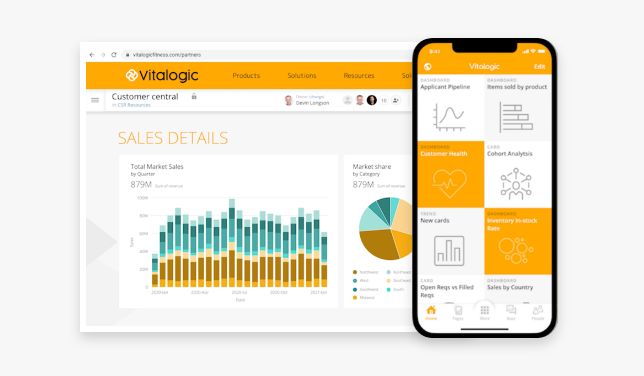What is ad-hoc reporting?
Not all business questions can be answered with existing metrics and KPIs. A business may track millions of different data points, and funnel this data into thousands of different user dashboards, but new problems can crop up that all of that data can’t solve.
Many older BI systems aren’t very good at reacting quickly to new problems. This is mostly due to how these products were designed and built. Older systems assume that their users have technical knowledge of the entire toolset. Often, it can take a whole team of experts to build out new dashboards in these systems.
In today’s world, businesses that want to compete need BI tools that can operate just as fast as they do. Most employees, not just BI experts, need to be able to quickly and easily create new metrics and dashboards.
Ad-hoc reporting is the ability to quickly build out new metrics and dashboards that serve to answer new business questions. Employees can create these data analytics much faster with modern cloud-based BI tools. Modern BI tools also rarely require the advanced technical expertise that older BI tools require.

Ad-hoc reporting allows employees to get the answers they need when they need them. This allows businesses to continue pushing forward in a fast-paced environment where they don’t have to wait for IT to create new dashboards and metrics. Even better, ad hoc reporting solutions are customizable. They work with existing data warehouses or other systems that desired metrics live in, and allow employees to flexibly create new metrics without extensive technical experience.
Agile businesses need to move as fast as possible to keep up with their competitors. Through ad-hoc reporting, businesses can find solutions to problems much faster than with BI tools that only allow for traditional reporting.
How can businesses benefit from ad-hoc reporting?
Choosing a BI tool that allows you to easily create ad-hoc reporting offers many advantages.
Ad-hoc reporting saves time. Now, instead of requests for data analytics bouncing around departments and between employees for months, the employee who needs a new visualization to answer their business question can create it themselves. This shrinks the workflow for new analytics from weeks to hours.
When it’s easy for employees to create their own visualizations, businesses can gain insight and implement solutions much faster. In today’s competitive business landscape, companies can’t afford slow reaction times. The ability to quickly analyze new data is crucial.
Empowering your workforce means giving your people the information they need to act quickly. When data is in a raw format, it can be uninterpretable. Training the decision-makers within your organization to build their own visualizations can cause huge culture shifts resulting in higher performance. When your employees can get answers as fast as they need them, it means that deadlines are met, customers are satisfied, and employees are happier.
Ad-hoc reporting helps everyone interact with data. Data experts shouldn’t be the only people accessing your BI tool. With BI tools that make ad-hoc reporting simple, anyone and everyone can interact with your data, use it to drive decisions, and draw fresh insights.
When everyone in an organization understands data, it’s much easier to create new reports. Everyone can understand, interpret, and analyze data together to create new actionable insights. This helps the entire organization work more cohesively, rather than just IT or business analysts having all the answers.

With ad-hoc reporting, everyone in your company can make smart decisions based on real data analytics. Data is much more powerful when everyone understands it. With the right data analytics, everyone in an organization can work together to get ahead of competitors and create new opportunities.
Ad hoc reporting helps bridge the gap between departments. When different departments are working with different types of data, but want to share insights based on that data, they need a way to communicate without any technical difficulties. With BI-enabled ad-hoc reporting, employees can spend less time explaining metrics and more time increasing revenue.
Departments need to work together cohesively. A decision in one department has an impact on the entire company. Unlocking the ability to eliminate silos not only at the department or team level but also at a company level, is crucial in building a competitive advantage.
Ad-hoc reporting helps teams look at data in new ways. Since everyone can access and utilize your data, team members can bring fresh perspectives to tough problems. The old adage rings true—when all you have is a hammer, everything looks like a nail. Ad-hoc reporting helps you to recognize when you need a screwdriver, and whether that screwdriver should be a phillips, flathead, or hex. It can add many new tools to your toolbox. In this way, ad-hoc reporting helps to find the best solutions to problems in the quickest possible way.
With a fresh set of eyes, teams find new ways to use data, look at it in different contexts, and start asking new questions. This helps businesses to stay ahead of the curve by spotting new opportunities and problems before they even arise.
Ad-hoc reporting lowers the workload of your data experts. When everyone can use your BI tool to analyze their own data, they don’t need to reach out to the experts for help as much. Now, employees don’t have to funnel every mundane BI task through the analytics team. This gives your data experts the time they need to work on complex projects where their subject matter expertise and insight are actually necessary.
What to look for in an ad-hoc reporting tool
Not all BI tools have the same quality of ad-hoc reporting capabilities. Even though the industry has trended towards ad-hoc reporting recently, many tools are still too complicated for the average employee. At a glance, some tools seem to have decent ad-hoc reporting capabilities but when you dig deeper, they lack features making them less useful than initially thought.
Here are a few qualities that a good ad-hoc reporting tool should have.
It should be easy to use. This is the bare minimum for an ad-hoc reporting tool. If an ad-hoc tool isn’t easy to use, then there’s very little advantage over traditional reporting tools.
Not only does this mean it should be easy for non-data professionals to use, but it also means it should have an intuitive UI. If the UI design of your ad-hoc reporting tool is confusing, you’ll never get the user adoption you need to gain the full benefit of your business intelligence solution.
Employees shouldn’t have to spend weeks of time learning how to use a new BI tool, and managers shouldn’t have to spend their time training development teams. If an ad-hoc reporting tool is simple and intuitive, employees will naturally jump in and start using it.
BI tools like Domo are simple, intuitive, and designed to be easy for everyone to use. They’re built with the idea that anyone, no matter their technical expertise, can take advantage of their ad-hoc reporting tools.
It should be accessible from anywhere. Cloud-based business intelligence software is much better for this kind of work than on-premises software. Ad-hoc tools need to work fast, and employees need to be able to work with them from anywhere. If something happens on a weekend or during a holiday, cloud-based BI tools allow access at any time directly from a laptop, phone, or tablet.
Flexibility is a major strength of cloud-based BI tools. They can be used from anywhere and in some cases even provide a mobile-native view for any report or dashboard.

It should be robust. Employees needing ad-hoc capabilities from their BI tools should be able to accomplish anything a data specialist using traditional BI reporting tools can do. Don’t think of ad-hoc tools as lesser versions of the tools data professionals use; they should be fully featured.
Dependability is another advantage of cloud-based BI. The system architecture of modern BI can assure its users that their data will be accessible at any time from any device. Additionally, a cloud-based architecture allows for extremely fast query response times even when analyzing large datasets.
Integrations should be simple. It should be easy for employees to collect the data they need to create their analytics. This means it should be simple to connect any data source you depend on for insights and action. Furthermore, once your data is connected, your ad-hoc BI solution should have ETL capabilities that will allow you to quickly normalize and transform your data with ease.
Ad-hoc reporting
Ad-hoc BI reporting is a powerful tool for businesses looking to save time and money. If you are tired of the endless hours spent combing through your data in search of insights, it’s time to explore Domo’s ad-hoc reporting tools. This unique platform allows users to quickly unearth valuable information about their business without having to spend days or weeks building reports from scratch. With more than 100 out-of-the-box visualization templates, as well as access to over 1,000 pre-built integrations to cloud systems such as Salesforce, Adobe Analytics, and others, our intuitive solution can be used by any sized company with ease.
RELATED RESOURCES

Report
Domo Named a Challenger in Gartner 2021 Magic Quadrant

Report
Forrester Study: The Total Economic Impact™ of Domo For Small and Medium Businesses

Report
Why Domo Is Dresner’s Top Cloud BI Pick Again

Guide